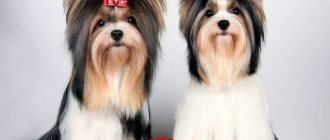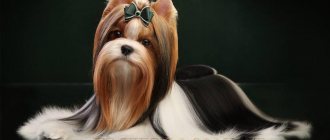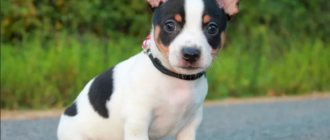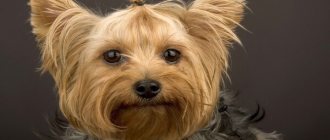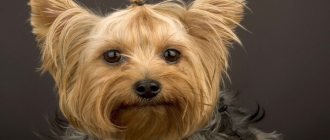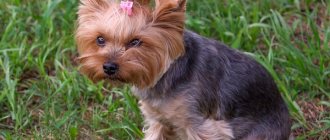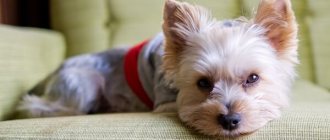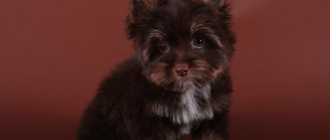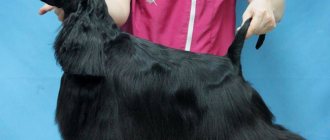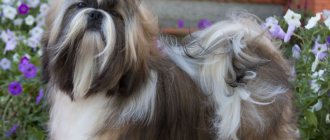The Yorkshire Terrier is a small breed of dog that is perfect for indoor living. The characteristics of Yorkies, their size and appearance affect their care and feeding. When keeping terriers, it is important to learn how to trim nails and fur, and care for the eyes.
The popularity of these miniature companion dogs is steadily growing. In our age of insane speeds, general alienation, lack of communication with an abundance of emotional overload, the small charming Yorkshire terrier becomes for a person a source of vital energy, a feeling of closeness and joy from communicating with a friend who is always nearby.
Yorkshire Terrier breed standard
The canonical types of Yorkshire terriers were established back in 1898, then supplemented in 2009:
- A long-haired dog, without down, so the hair falls evenly.
- The posture is compact and graceful, the body is strong.
- The head is small, without a prominent nose.
- Scissor bite.
- The ears are erect and covered with fur.
- The paws are straight, both the front and rear legs are straight, the shoulders are regular and symmetrical.
- The tail is docked or undocked. The latter is as straight as possible and complements the line of the back. And the docked one is worn a little higher. Both options are considered acceptable.
Varieties of Yorkshire terriers exist only among breeders experimenting with the size of their pets. The standard adopted in the CIS countries in 1988 does not define a minimum weight limit, setting only a maximum of 3.1 kg.
Perhaps you will be interested in reading about the most unusual cat breeds? Then follow the link https://porodakoshek.ru/porody/top-20-redkix-porod-koshek-opisanie-foto-i-stoimost.html.
Rock defects
Yorkies with:
- semi-erect ears;
- underbite or underbite;
- non-standard color;
- cryptorchidism.
Defects also include too bulging or incorrectly set eyes, defects in the structure of the paws, lack or modification of teeth, a short or long massive neck, and a low-slung croup. It is noteworthy that animals that are not gaining weight are traditionally not welcomed.
Wool
For the Yorkshire Terrier, the quality of the coat, its structure and length are very important. The coat on the body should be smooth, long, completely straight, without waves, curls or hints of fluffiness. The fur on the back should be parted down the middle and flow down the sides of the Yorkie. The coat can be trimmed to ground level, thereby making it easier for the Yorkshire Terrier to move and giving it a neat and well-groomed appearance.
The hair on the head should also be long, it must be collected in a tail in the middle or in 2 tails on the sides. The ears need to be trimmed short, and the hair on the paws can also be trimmed - this gives the Yorkie a more well-groomed appearance. If we talk about the fur of the Yorkshire Terrier outside the breed standard, it is worth highlighting the following important facts:
- The structure of the coat is similar to the structure of human hair. The wool does not cause allergies, hardly falls out and grows quickly - about 15 mm per month.
- In order not to damage your pet's fur during combing, you need to choose the right comb: natural bristles are suitable for regular procedures, but a metal comb is needed to comb out tangles.
Using a slicker comb can damage your Yorkie's skin.
Yorkshire Terrier breed large standard
These are the so-called big Yorkies. In fact, this is the optimal size for a small animal. A large Yorkshire Terrier weighs from 2 to 3.1 kg. He has a balance between size, classic appearance and health.
Dogs exceeding the 3.1 kg mark are outside the breed limits. This is not a problem if the “Yorkshire Terrier Maxi” is bought exclusively as a pet and will not participate in exhibitions. But he is not suitable for breeding, since he does not have the canonical weight.
The Great Yorkshire Terrier may appear due to the mating of a large male and female, or due to the mixing of species with another, larger one.
Color
From the back of the head to the base of the tail, the coat should have a gray-steel, but not silver, tint. Insertion of red, bronze or dark colored hair is not acceptable. The chest and paws from the ground to the elbows and knees are covered with bright and rich golden-brown fur with darker roots.
The coat on the head also has a golden-brown tint, more saturated on the sides, near the ears and in the muzzle area. The ears are reddish-yellow-brown in color. This color should not extend to the neck and mix with the main one.
Yorkshire Terrier puppies are born with a black coat color and small spots of red tan; it is impossible to predict the color of an adult dog.
Yorkshire Terrier mini
Stand out as amateurs. People unfamiliar with the official standards should study all the information about these conventional varieties before purchasing a puppy. Artificially reduced dogs often have genetic abnormalities and diseases from birth that significantly shorten their lifespan.
Mini Yorkie: standard
The main indicator is weight from 1.5 to 2 kg. Such puppies are obtained when a standard female and a small male are brought together. When buying puppies, it is important to pay attention to their condition: unscrupulous breeders underfeed them, achieving miniature size. This affects:
- the already fragile health of Yorkies;
- psychological state of the pet;
- his training abilities.
If standards quite successfully assimilate commands, have a calm and balanced character, then reduced representatives experience difficulties in learning and are aggressive towards others. When getting a dwarf Yorkshire terrier, you should remember that the smaller the dog, the more difficult it is to care for and train it.
Difficulties in caring for a micro Yorkshire terrier
Completely dwarf Yorkies or super minis weigh up to 1.5 kg. These pets are different:
- poor health, problems with the skeleton, internal organs;
- low intelligence;
- short life.
Sure, they look cute, but keeping a Micro Yorkie is very difficult. He must be protected from falls even from a small height; when running, they often break limbs. In addition, due to its low intelligence, the mini Yorkshire Terrier is difficult to train.
Mini and super mini bitches are not suitable for breeding. They are unable to bear and give birth to puppies normally. The temptation to get a dog smaller than a cat is quite strong, but you need to be prepared for serious difficulties.
The smallest Yorkshire Terrier in the world was born in 1945. He weighed only 113 g, but he died after 2 years of life. The height of the withers was 6.3 cm, and the length from nose to tail was only 10 cm. And the title of a modern miniature dog belongs to the Big Boss terrier. His height is 11.9 cm and weight is about 500 g.
How to care
Caring for your Yorkshire Terrier is an essential part of your life together with your dog. The result of proper and careful care is his health, beautiful appearance and your mood accordingly. So, care should include:
- cleaning teeth, ears, eyes;
- nail trimming;
- wool cutting;
- bathing;
- combing;
- oiling wool;
- winding curls of wool onto curling irons.
Video instructions for care principles
Eyes
You need to take care of your eyes daily. In the morning after sleep, be sure to wipe the corners of your eyes with warm boiled water or a solution of chamomile infusion. Use soft cotton swabs to remove any secretions that have accumulated overnight. Excess moisture after wiping the eyes also needs to be removed. After this, the hair around the eyelid is combed with a toothbrush.
Ears
The ears are also wiped with water or a special lotion as the ear becomes dirty. But at least once a week. Let us remind you that unpleasant odor from the ears or dark brown plaque is not allowed. In this case, you need to contact a veterinarian.
Teeth
Your Yorkie needs to have his teeth brushed to prevent tartar buildup. It comes from dog food scraps. To do this, use either special toothpastes with brushes, or use dog treats to clean your teeth; they are usually made from compressed tendons. Failure to take proper care of your dog’s oral cavity can lead to inflammation and bleeding of the gums, and subsequently to tooth loss. Brushing your teeth more often is enough 1-2 times a week.
How to trim claws
Yorkshire Terriers' nails need to be trimmed as they grow. For Yorkies this is usually once every 1-2 weeks. But, if the dog often walks on the asphalt, then the claws will wear down on their own. If you still need to trim, then contact the veterinary clinic for the first trimming. There they will show you how to trim correctly and to what length, so as not to hurt the living (sensitive) part of the claw. Then the procedure can be carried out independently using special nail clippers and files (for sharpening).
Grooming – haircut at home
Yorkies' coats are trimmed with a clipper, scissors and a soft comb. Every 2 weeks, the hair around the anus, under the arms, between the toes and on the tips of the ears (upper 1/3) is trimmed. This is a hygienic dog grooming. This procedure is mandatory for all dogs.
If you are not going to exhibit your Yorkie at exhibitions, then a standard haircut for your Yorkie, which will be done after 2-3 months, is suitable for you. With this type of haircut, the hair is kept neat, gets less dirty and does not require curling into curling irons.
You can cut your dog’s hair either on your own or in a salon. For a model haircut (for show dogs), use the services of grooming salons. Here your imagination can run wild and you can give the dog different shapes (like a poodle or a lion, with pants or with bangs).
How to wash a Yorkshire Terrier
Washing the Yorkshire Terrier is often not allowed. It is advisable only when soiled, but at least 2-3 times a month. From a young age you need to accustom your Yorkie puppy to this procedure. The water should be slightly warmer than room temperature (30 - 35 degrees), the flow of water should not be strong, so as not to scare the baby.
It is advisable to use shampoos special for Yorkies, or for breeds with long, silky hair. It is recommended to dilute the shampoos with water 50/50, rub thoroughly in your hands and only then apply to the dampened coat in the direction of hair growth (so that the coat does not get tangled). Try to prevent water from falling into your ears; you can plug them with cotton balls.
After washing, the shampoo is thoroughly rinsed off and a conditioner or conditioner is applied - a rinse for easy combing (rinse off thoroughly with water). Dry your dog with a terry towel and hair dryer. The air flow should not be hot or fast. Place the fur in the direction of hair growth on the body and against the direction of hair growth on the paws. And we apply a spray - conditioner or oils to soften the coat.
Lubrication with oil is necessary in order to anoint already dry and combed wool. To do this, use burdock, coconut, almond or bamboo oils. You can also use nettle, peach or wheat germ oil. Dilute half a teaspoon of oil in 100 ml of distilled water and apply to strands using a spray. When the water dries, the coat becomes soft, silky and easy to comb.
Winding on papillots. It is produced so that the wool does not get tangled and protects it from excessive dirt and tangles. After the wool has dried. For this purpose, plastic papillots or strips of special (rice) paper are used. The wool is divided into strands (up to 15 strands) and wrapped along the entire length in a paper strip, then rolled up and secured with an elastic band. To ensure that curls do not interfere with a walk, special robes and overalls made of natural silk are worn. The dog walks like this until the next bath. But this is an option for show Yorkies.
Combing
To properly comb your Yorkie you need:
- massage brush with natural bristles
- metal massage brush with antistatic coating
- comb with rotating teeth
If you do not curl the wool into curling irons, the coat must be combed daily. If tangles have formed or your hair is very tangled, first smooth it out with your hands and only then with a comb.
Which Yorkie is better: standard or mini?
Due to the great demand for dwarf breeds, their price is rapidly increasing. However, professional breeders recommend choosing a pet from 2 to 3 kg, i.e. large standard. It has significant advantages:
- health and normal immunity;
- possibility of breeding;
- learning ability;
- he is recognized at shows in the classics of the breed.
He gets along well with children and other dogs. Miniature puppies also appear in standard-sized Yorkies. But breeding them on purpose is a risky and unjustified activity.
Breeds are already degenerating due to selection: modern terriers are much sicker than they were 100 years ago. Therefore, when choosing a pet, it is advised to choose recognized standards so as not to be disappointed by the short life of the dog.
Character
Yorkshire Terriers are very active and energetic dogs that have difficulty sitting in one place. They quickly become attached to their owner, are devoted to him and are always ready to defend him. They treat strangers well and kindly, but not from the first minutes - they need time to adapt. They feel great in a pack, are friends with other dogs and even cats, love children and get along easily with them.
The peculiarity of the nervous system is rapid excitation and a rather long process of calming down. They have a choleric temperament and are not characterized by fearfulness and aggressive behavior. Despite the fact that now Yorkies are decorative dogs, the blood of their ancestors remains in them and even the smallest representatives of the breed are capable of hunting.
Among the positive qualities of the Yorkshire Terrier are:
- Equilibrium.
- Friendliness.
- Attentiveness.
- Playful character.
Negative qualities:
- They do not tolerate loneliness well.
- They need a special approach to education.
Yorkshire terriers have a high level of intelligence, the breed is included in the TOP - 50 smartest animals.
Head
The dog's head is small, the skull should be flat, and the muzzle should be quite short. It is important that the dog's head is absolutely proportional to its body. The correct bite is a scissor bite, in which the upper row of teeth well covers the lower one. Teeth should be strong and straight.
The animal's eyes are not too large and shiny. The eyelids and nose are dark in color, the nose should be almost black. Dogs' ears are very miniature, pointed upward. In the cartilage area they are quite flexible and completely covered with short hair of a darker color than the rest of the face.
We recommend this article:
Pros and cons of the Yorkshire Terrier dog breed
It should be borne in mind that although at the moment the variety of Yorkies with the so-called “baby face” (short muzzle and huge surprised eyes) is extremely popular, this variety is not included in the standard. Moreover, due to this structure of the dog’s muzzle, dogs have a whole range of diseases - they are often diagnosed with chronic conjunctivitis and breathing problems.
Muzzle and jaw
- Short muzzle with black nose and lips.
- Scissor bite; when closed, there is no gap between the lower and upper jaws.
Representatives of this breed traditionally have fragile teeth.
Eyes
Medium in size, set straight, gaze directed in the direction of movement. Almost round, slightly convex and close to each other. The iris of the eyes is of dark tones; light ones are not welcome.
Ears
Small, with little fur. The shape resembles an inverted "V". They are not located far from each other. The color on the ears tends to stand out.
Neck
Long, toned, with a clear contour of the scruff. Set high. Completely hidden behind fur.
If the dog's eyelids, nose and lips are a color other than black, the dog will be disqualified from the show.
To read: Recommendations for choosing a nickname for Chihuahua dogs
Brief history of origin
The British Isles are considered the homeland of the Yorkshire Terrier, and the name of the breed comes from the county of Yorkshire, where breeding work was carried out.
This is interesting. Russian-speaking dog breeders jokingly call the breed “ruff terrier.”
Scientists have several options for the origin of the Yorkshire Terrier breed. According to the main version, their origin is from Maltese lapdogs and other small terriers. According to another, dogs resembling modern Yorkies were brought from Scotland.
In any case, the history of the breed goes back about one and a half centuries. The official breed standard was approved in 1898 and is still in effect today with some additions.
Expert opinion
Leonid Rodin
Experienced dog breeder
Ask a Question
York's high-society debut took place along with the demonstration of a photograph in the ceremonial dress of Princess Alexandra of Wales. On the lap of the young aristocrat sat a small dog with a very recognizable appearance. In itself, a photograph from the 1860s can already lay claim to historical uniqueness. And the presence of a Yorkshire Terrier on it makes it an important artifact documenting the development of the breed. It is interesting that at this moment the little ratcatchers were not even listed in the studbook of the English dog breeding community. This happened 10 years later. Despite such a high-society start, Yorkies never gained a foothold in the royal chambers as a fashionable four-legged accessory. Real popularity came to them only in the twentieth century as companions of movie, sports and show business stars. This movement was started by Audrey Hepburn, who literally infected Hollywood with a passion for small York terriers.
When we choose a puppy
To choose the right one, you should know that puppies are born darker in color, and subsequently they change coat color. All puppies at the age of 2 months have black hair at the base and lighter at the tip. They all give the impression of being strong, because they have not yet stretched out or grown up. To understand what shade a dog will be, you need to study the parents and the entire pedigree. Because even standard dog breeds can give birth to mini puppies, anything can happen.
Also pay attention to the appearance of a standard puppy, if he is cheerful, and his eyes are shiny enough, there is no bad smell from his mouth, and the kennel is kept clean, most likely the puppy is already yours. Before purchasing, don’t forget to touch the belly and play with it a little; if the Yorkie makes contact without problems, everything is fine.
The following are also considered deficiencies and deviations:
- Undershot or overshot, jaw curvature;
- A curved, indirect body or in the form of an overly elongated rectangle;
- Short or long muzzle;
- Ears close or wide apart;
- Hind limbs in the shape of the letter X or O;
- The tail is carried at or below the level of the back;
- Uneven color (splashes of dark or ashy hair on a reddish head, for example);
- Cryptorchidism.
Also check whether the dog hears, breathes, and sees you well; if in doubt, come to the kennel again. But you must make the right choice, and even if your dog does not attend exhibitions, we believe that he will become your best friend forever.
